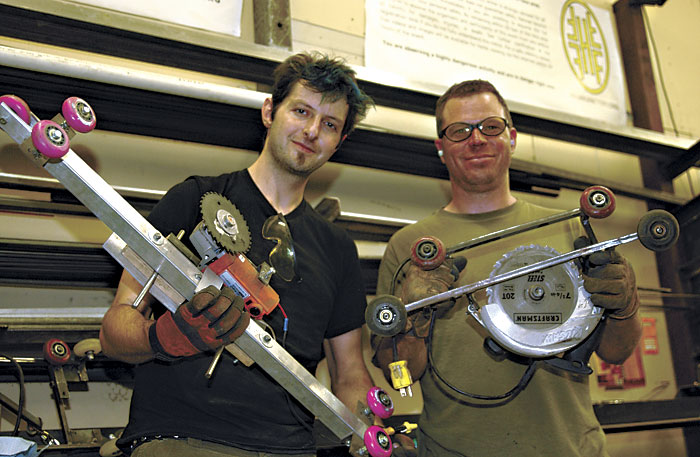Any sensible contractor wears steel-toed boots for a variety of safety reasons. Dropping a concrete block or a toilet on one’s foot is a hazard of the trade. Or a skill saw, its trigger locked, could fall through a sheet of fresh-cut plywood, grip the floor with its spinning teeth, speed across the room, and sever 10 toes in the process. A trip to the ER could result. Or a race.
The origins of power-tool racing are murky. And for romantic reasons, we should allow them to remain that way. Some say the sport came from New England, leapt to the Bay Area, and reached Georgetown in 2003. Think of it as a low-budget, DIY amalgam of drag strips, soap-box derbies, robot wars, and slot-car racing. In 60-foot wooden channels bounded by two-by-fours, trailing orange extension cords or (more rarely) pneumatic air hoses, bastardized power tools compete for speed, appearance, and general badassery.
Speeds can exceed 60 mph, meaning a race can last mere seconds. But the stopwatch matters less than the judging and audience response: Is this tool cool? Does it come adorned with Hello Kitty figurines, tiki torches, lawn sprinklers, rubber chickens, or Barbie dolls? Does it do other stuff besides race? Anyone can go fast. But to go slower, with style, separates the spiffy new DeWalt from the embellished old Craftsman yard-sale find.
“It’s not truly a race; we give awards on the basis of what gets the crowd going,” says Rusty Oliver of arts collective Hazard Factory. He and Jeremy Franklin-Ross have organized events in Seattle and cities as far away as Amsterdam. (They generally also compete in the meets.) Like drag racing, entrants face off in heats of two, but with the crowds much closer to the noisy action (separated, for safety, by a short fence). “Power tools” is an elastic category, Oliver explains: Racers have been built from belt sanders, industrial grinders, lawn mowers, chain saws, and even kitchen eggbeaters. This year, he adds, “I really want to see a vacuum cleaner. I am dying for someone to race a blender that can produce a drink at the end of the race. We’re hoping someone can make a margarita.”
Where do such unlikely vehicles come from? “We go down to the thrift store,” says Franklin-Ross. “Every year I like to challenge myself.”
On a recent evening, racing tools are in various stages of readiness in the South Park industrial shed where Hazard Factory is based. Oliver and Franklin-Ross are conducting a building/beer-drinking session with other contestants and fine-tuning their own creations. Most employ guide wheels taken from old rollerblades. Various outriggers and fittings are bolted or welded on. The key is to transmit power—whether by saw blade or fan blade—onto the track. Or even the upright rail. Franklin-Ross demonstrates one spidery contraption that clings to the two-by-four lane divider just like the monorail. The engineering is ad hoc, he explains: “Bungees and washers—whatever works.”
“It’s not a sport that works well for people who take themselves seriously,” says Oliver. “We do as little as possible to regulate the event.”
Conspicuously absent are radio controls, circuit boards, RAM cards, and the like. Tool racers are meant to be dumb, scuttling, mutant beasts; they’re designed not in a NASA clean room but on a cluttered workbench. Blueprints would be like cheating. The design vibe is that if something unnecessary can be bolted on, it should be bolted on. Some of the names from last year’s Georgetown contest reflect the ethos: Blade of Mutilation, Sled Menace, El Fantastico, and The Lobster. It’s like Mad Max meets Mexican wrestling. (On race day, a boisterous emcee also helps work the crowd; rumors of drinking abound.)
As a cultural phenomenon, power-tool racing has been written up in both The New York Times and Popular Science. (That mag still exists?) Oliver and Franklin-Ross have even done a pilot episode for the Discovery Channel. “We’re hoping to get a series,” says Oliver. What makes the Seattle event unique, according to Franklin-Ross, is that “We up the crazy scale by adding the demolition-derby aspect,” meaning the tools ultimately hurl themselves to oblivion. Ramps are even employed to vault the vehicles into a backstop. In past years, unlucky cars have been the target. Says Oliver, “Normally we stop when we’ve destroyed everything.”








